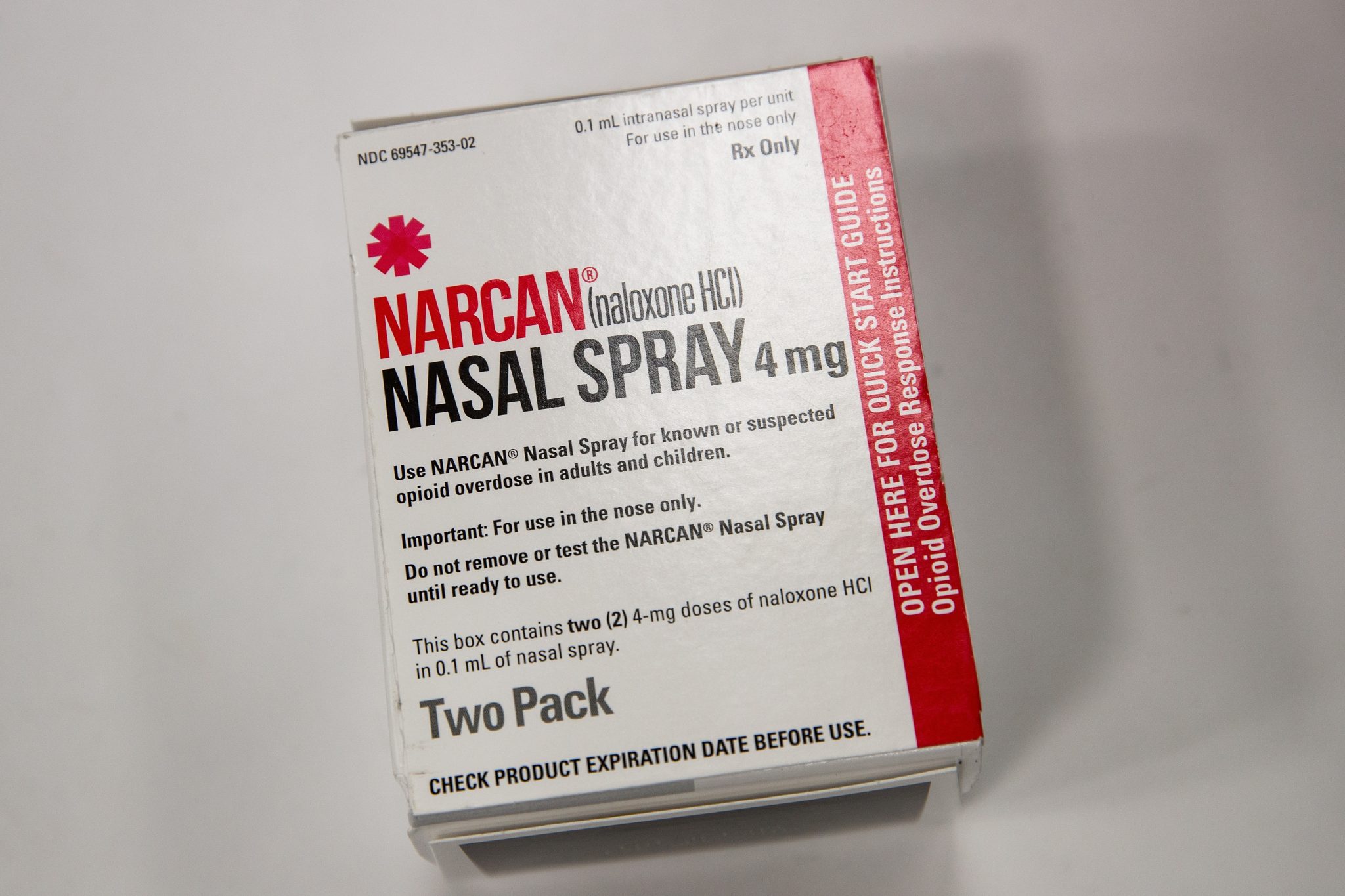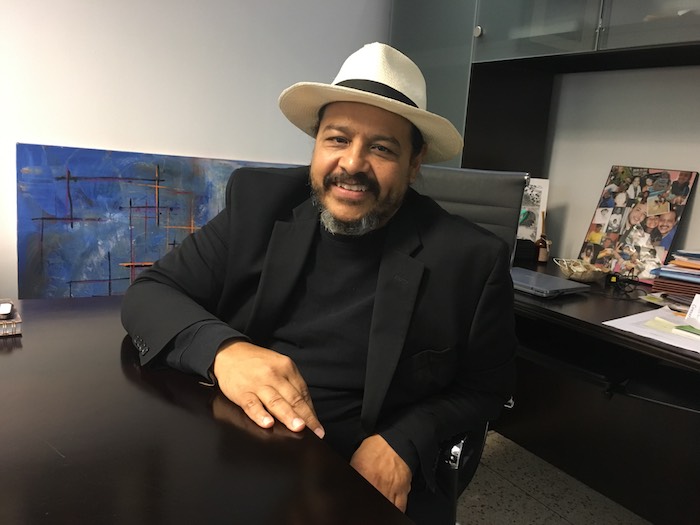

The iconic mural on the back wall of Intercambios Puerto Rico, taken before Hurricane María. 150-mph winds have since peeled most of the finished surface off, but the building remained mostly intact. (Photo by Joaquín Cotler)
After stalling in the Puerto Rican House of Representatives for a year, Senate Project 341, a bill that would pave the way for drug policy reform and opioid overdose prevention in Puerto Rico, was finally reviewed by members of the island’s lower House. After some adjustments, the bill is back in the hands of the Senate, pending approval before it’s sent to Governor Ricardo Rosselló.
Experts say that ratifying PS-341 would be a major step towards preventing opioid overdose in the island. The bill, unanimously passed by the Senate upon its introduction by the Senate Health Committee in April of 2017, would allow for easier public access to Narcan, the opioid overdose reversal drug currently illegal for civilian use in Puerto Rico. The bill also included a clause protecting drug users, dealers, and their associates from prosecution—should they choose to use the drug to stop an overdose in progress.
“It’s our version of the Good Samaritan law,” said Gladys I. Nieves Vázquez, the associate director for El Punto En La Montaña, a tiny mobile syringe exchange in Caguas and other municipalities (Cayey, Cidra, Aguas Buenas, Comerío).
According to Nieves Vázquez, PS-341 would protect her organization from prosecution for providing access to the antidote, a key part of El Punto’s mission.
“We’ve managed to coordinate getting Naloxone to our participants, and we’ve seen between eighty and one hundred overdose reversals in two years,” Nieves Vázquez told Latino Rebels.
A Rise in Overdose Deaths
The conversation surrounding Narcan in Puerto Rico comes at a crucial time. Nieves Vásquez is hosting a workshop about the dangers of fentanyl in rural Puerto Rico at the National Harm Reduction Conference in New Orleans this weekend, a summit attended by overdose prevention activists, experts and outreach workers from around the United States. The steep rise in overdose deaths over the past five years is largely due to the ubiquity of the cheap, synthetic opioid fentanyl in the current American heroin market, underscoring the importance of the role Narcan plays as a last line of defense.
For people who inject drugs, the risk of accidentally injecting fentanyl —which can be 50 to 100 times stronger than heroin— increased exponentially after Hurricane María. But despite Narcan’s proven efficacy (oftentimes a double or triple dose of Naloxone can stop an otherwise fatal overdose dead in its tracks), the medication is difficult to obtain in large quantities.
In 2017, the Medical Emergency Response Agency (AEMEAD) reported 612 overdose related interventions in Puerto Rico. That number does not include Narcan “saves” or reversals that were not reported to the authorities, which outreach workers say could be the majority.
Yet despite the island’s current drug policy, there is still Naloxone in homes, businesses and shooting galleries, thanks to small non-governmental organizations.
‘You Can Send Me to Fucking Jail If You Want’
“It’s illegal. We do it illegally in the mountain,” said Camila Gelpi-Acosta, El Punto’s co-founder. “We’re flooding the mountain illegally with Narcan. I’m proud to say that you can send me to fucking jail if you want. Seriously. We’re trying to save lives here.”
The community El Punto Works with is small, but it’s not served by other harm reduction or public health organizations. Much of Puerto Rico functions the same way: Narcan, sterile needles, and medical supplies are available hyper-locally, mostly through syringe exchanges. There are a handful throughout the island, from Fajardo to Mayaguëz.


A package of NARCAN (Photo Illustration by Drew Angerer/Getty Images)
Carla Correa Cepeda works with Intercambios Puerto Rico, a syringe exchange in Fajardo. She is coordinating a series of ongoing tests to determine the presence of fentanyl on the island. Correa Cepeda says that for the past year, in all 19 communities Intercambios serves on the island’s east coast, fentanyl is still in 90% of the heroin supply. But she explains that actual overdose numbers are hard to determine, and that the government isn’t in a hurry to do so.
“We are doing the work and we want to help, but it is much easier to ignore the problem,” Correa Cepeda said. “If it is not talked about, it is not discussed, it is as if it did not exist, although people are still dying.”
Correa Cepeda added that because the people she works with are mostly poor or homeless, that their needs are routinely overlooked.
“Juan del Pueblo does not matter to anyone,” she said.
Gelpi Acosta agreed.
“The Puerto Rican government wants its drug users out,” she noted. “They don’t want to deal with it, they don’t want to deal with them. Period.”
Official Data Hard to Determine
While public health workers and harm reduction advocates acknowledge the severity of the overdose problem, the true scope of the opioid epidemic actually is very hard to gauge. There is no official government data, and most fatal overdoses are not reported as such. Instead, they get listed as respiratory failure, cardiac arrest, or whatever health problem is easily associated with the person’s death.
On top of that, while health professionals say that as overdose numbers are seemingly increasing, the causes of hundreds of deaths associated with Hurricane María have still not been officially determined. This is largely due to the fact that there are just too many recently deceased people for the island’s only official medical examiner’s office to certify.
“The Forensic Science Institute is currently undergoing a crisis worsened by Hurricane María. This situation results in just sixty certified fentanyl related deaths in 2017 and about 100 in 2018,” Nieves Vázquez said.
She noted that these figures are much lower than organizations serving people who inject drugs have experienced.
“We need to find a more effective way to certify that overdose related deaths are in fact caused by opioid overdose,” Nieves Vázquez explained, “and whether or not they are influenced by fentanyl.”
Rosselló’s Executive Order
On August 31, 2017, Rosselló announced the formation of an opioid overdose prevention board that would focus on Naloxone distribution, training and comprehensive overdose monitoring through the island’s Administration of Addiction and Mental Health Services.
Firmamos hoy una Orden Ejecutiva para establecer el grupo de trabajo para la prevención de muertes por sobredosis de opiaceos en Puerto Rico pic.twitter.com/2NKGDYmCRW
— Ricardo Rossello (@ricardorossello) August 31, 2017
The team was supposed to be a partnership between several government entities, including the Department of Corrections ASSMCA, and several non-governmental organizations already working in overdose prevention. The task force’s spokesperson Cieni Rodríguez said in late 2017 that the government was planning to work directly with the NGOs to train police and first responders how to administer Naloxone.
“We’ve already ordered the Narcan,” Rodríguez said at the time.
Despite initial reports that the trainings had been canceled, ASSMCA administrator Susanna Roig Fuentes said some took place early this fall, led by Torruella of Intercambios While the government could not provide details about the task force’s other partners, Fuentes mentioned that “El Punto [en] la Montaña was selected as part of the NGO’s that will be providing outreach services through a contract with the agency. The contract is under process.”
Yet according to several members of El Punto, it isn’t clear which NGOs have been selected to represent non-profit organizations on the Task Force. Roig Fuentes also said the interagency task force’s main mission is to gather the information about overdoses in Puerto Rico to help prevent more in the future.
“ASSMCA uses the information that is provided to develop new intervention strategies. Our next step is to work towards their integration in an Electronic Overdose Surveillance System,” said Roig Fuentes.
But according to Nieves Vázquez of El Punto, the surveillance system, which uses the ODMap platform, is not yet functional. And the data regarding overdose deaths is incomplete at best–which makes gaining an understanding of the breadth of the problem difficult.
“Puerto Rico’s overdose related deaths are not officially documented. There’s been no government report since 2015. We need to find a more effective way to certify that overdose related deaths are in fact caused by opioid overdose, and whether or not they are influenced by fentanyl,” she said. “El Punto en la Montaña has been focused on gathering data regarding overdose instances and overdose related deaths and fentanyl since the first news regarding fentanyl-laced heroin entrance in Puerto Rico in March 2017.”
Just the Beginning?
Gelpi-Acosta added that while these are necessary first steps, they’re just the beginning. She believes that in order to take control of the overdose epidemic, the government should regulate the island’s heroin supply.
“It would stop the fentanyl overdoses,” she said.“They would be regulating and controlling the drug. Not the drug lord anymore. Therefore, there’s no more fentanyl. There’s no more overdoses.”
Senator José A. Vargas Vidot, chairman of the Senate Health Committee, has similar ideas. The island’s first independent senator-at-large, Vargas Vidot began his career as a medical doctor. A long-time harm reduction advocate, he provides free healthcare for homeless people, and founded the first syringe exchange in San Juan.


Senator José A. Vargas Vidot in his San Juan office. (Photo by Joaquín Cotler)
In May of 2017, Vargas Vidot and the committee introduced Project 341. In addition to legalizing Narcan, it would open the door for more progressive drug policy, like safe injection sites, regulated heroin, decriminalization and qualitative care evaluation.
“We have been working for months to bring about the possibility that for the first time in history, the government approve a plan that has measurable objectives,” Vargas Vidot explained. “And in that plan, we can take responsibility for other aspects of drug use. If we treat someone’s drug use without addressing the initial problem, it’s like if someone is painting and I say ‘grab the brush, but I’m taking the ladder.’ He’s going to fall.”
In Puerto Rico, Vargas Vidot noted, an island-wide standard by which drug treatment is measured or evaluated doesn’t exist, and what treatment does exist needs to be drastically improved.
“It has never been science-based,” he said. “This is what we are trying to do now.”
Though PS-341 is currently awaiting final Senate approval, Senate President Thomas Rivera Schatz has not yet had a chance to read it.
***
Joaquín Colter is a journalist who has covered the opioid epidemic in New York City, Long Island, and Puerto Rico. A CUNY Graduate School of Journalism alum, Joaquín has worked as a production intern and contributing producer at Studio 360, a reporting fellow and composer at The GroundTruth Project and an audio producer for Latino USA. He keeps Puerto Rico in his heart, which he wears on his sleeve. He tweets from @ShinyIslands.


